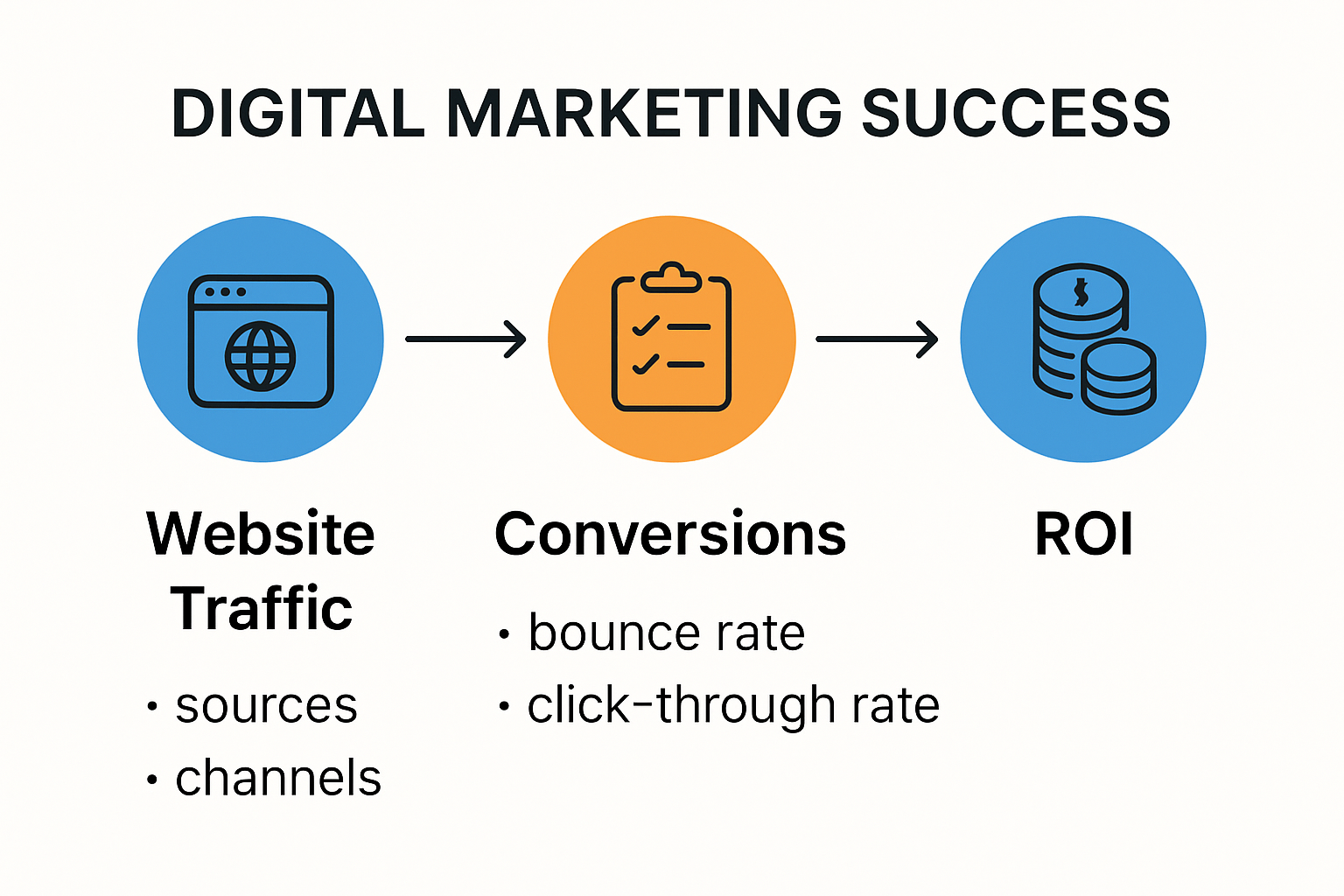Small business owners often look at endless spreadsheets and wonder which numbers truly matter. The mountain of statistics can get overwhelming, but one fact stands out. Companies that track and act on key marketing metrics are 3 times more likely to achieve revenue growth. That might sound like pure number-crunching, but here’s the surprise. The real magic is not just in collecting the stats, but in how you connect them to everyday decisions that shape your future profits.
Table of Contents
- Understanding Key Marketing Metrics In Business
- Essential Metrics To Measure Digital Success
- How To Use Marketing Metrics To Grow
- Common Mistakes And How To Avoid Them
Quick Summary
| Takeaway | Explanation |
|---|---|
| Track Key Performance Metrics | Focus on essential metrics like conversion rates and customer acquisition costs. These insights guide strategy and decision-making effectively. |
| Understand Data Context | Analyze metrics in relation to goals and market factors. Context helps to interpret results meaningfully and avoid misinterpretations. |
| Optimize Resource Allocation | Use performance insights to redirect marketing investments towards high-return channels, transforming marketing into a growth driver. |
| Continually Review Metrics | Regularly assess and adapt based on metrics to stay responsive to market changes and customer needs for sustained growth. |
| Avoid Data Isolation | Treat marketing metrics as interconnected insights rather than isolated figures; this holistic view fosters better strategic decisions. |
Understanding Key Marketing Metrics in Business
Marketing metrics transform raw business data into actionable insights that drive strategic decision making. Small businesses operate in a complex marketplace where understanding performance indicators is not just beneficial but essential for survival and growth. Learn more about strategic marketing analytics to unlock your business potential.
Why Marketing Metrics Matter
Marketing metrics provide a quantitative framework for evaluating business performance. According to the University of Florida IFAS Extension, these metrics help businesses assess sales growth, market share, and customer conversion rates. By tracking these indicators, small business owners can make informed decisions that directly impact their bottom line.
The significance of marketing metrics extends beyond simple number tracking. They offer insights into customer behaviour, campaign effectiveness, and overall business health. Metrics reveal patterns that might otherwise remain hidden, enabling businesses to optimize their marketing strategies and allocate resources more efficiently.
Interpreting Marketing Data Effectively
Successful interpretation of marketing metrics requires a nuanced approach. Raw numbers mean little without context and strategic analysis. Business owners must understand not just what the metrics show, but why they matter and how they interconnect.
For instance, a high website traffic number means little if those visitors do not convert into customers. Similarly, customer acquisition costs must be weighed against lifetime customer value. This holistic view allows businesses to understand the true impact of their marketing efforts and make data driven decisions.
By developing a comprehensive understanding of key marketing metrics, small businesses can transform data into a powerful strategic tool. These metrics serve as a compass, guiding businesses through the complex terrain of modern marketing and helping them navigate towards sustainable growth and success.
Essential Metrics to Measure Digital Success
Digital marketing success hinges on understanding and tracking critical performance indicators that reveal the effectiveness of online strategies. Small businesses must go beyond vanity metrics and focus on meaningful data that drives actionable insights. Explore digital marketing strategies to transform your online presence.
Website Performance Metrics
According to OpenStax’s ‘Principles of Marketing’, website metrics are fundamental to understanding digital marketing performance. Key indicators include website traffic volume, traffic sources, and user engagement rates. These metrics provide a comprehensive view of how potential customers interact with your digital platforms.

Traffic sources reveal which channels drive visitors to your website. Whether through organic search, social media, paid advertisements, or direct visits, understanding these pathways helps businesses optimize their marketing strategies. Bounce rates and average session duration offer insights into content relevance and user experience, indicating whether your website effectively captures and retains audience attention.
To provide a clear overview, here is a summary table of essential website performance and engagement metrics discussed in this section. Use this as a reference when evaluating your own digital marketing success.
| Metric | What It Measures | Why It Matters |
|---|---|---|
| Website Traffic Volume | Total number of website visitors | Indicates overall reach and interest |
| Traffic Sources | Origin of site visitors (organic, social, paid, direct) | Helps identify effective channels |
| Bounce Rate | Percentage leaving after viewing one page | Reveals content relevance and site appeal |
| Average Session Duration | How long visitors stay on the site | Measures engagement and content effectiveness |
| Conversion Rate | % visitors completing desired actions | Shows how well site turns interest into results |
| Click Through Rate (CTR) | % clicking links or ads | Reflects engagement with calls to action |
| Email Open Rate | % opening marketing emails | Gauges email campaign effectiveness |
| Customer Acquisition Cost (CAC) | Cost to acquire a new customer | Assesses marketing spend efficiency |
Conversion and Engagement Metrics
Conversion metrics transform website visitors into tangible business outcomes. Conversion rates track the percentage of visitors completing desired actions such as purchasing products, signing up for newsletters, or requesting consultations. These metrics directly correlate with marketing effectiveness and revenue generation.
Engagement metrics complement conversion data by measuring audience interaction quality. Click through rates, social media interactions, email open rates, and video view durations provide nuanced understanding of content performance. High engagement suggests your digital content resonates with target audiences, creating opportunities for relationship building and brand loyalty.
Return on Investment Metrics
Ultimately, digital marketing success is measured through return on investment (ROI) metrics. Customer acquisition cost, lifetime customer value, and revenue generated from digital campaigns offer concrete evidence of marketing strategy effectiveness. By comparing marketing expenditure against generated revenue, businesses can make informed decisions about resource allocation and strategy refinement.
Comprehensive tracking of these essential metrics enables small businesses to navigate the complex digital marketing landscape. Each metric serves as a strategic compass, guiding decision making and helping businesses adapt to evolving online consumer behaviors. The key lies not just in collecting data, but in transforming these insights into meaningful actions that drive business growth.
How to Use Marketing Metrics to Grow
Transforming marketing metrics from raw data into strategic growth tools requires a systematic and thoughtful approach. Small businesses must move beyond passive data collection to active performance analysis that drives meaningful business expansion. Discover advanced marketing analytics techniques to accelerate your business growth.
Identifying Growth Opportunities
According to the Better Business Bureau, key performance indicators like Cost Per Acquisition (CPA) and Customer Lifetime Value (CLV) are critical for understanding business potential. These metrics reveal not just current performance but future growth trajectories. By carefully analyzing customer acquisition costs against their long term value, businesses can identify which marketing channels and strategies deliver the most sustainable returns.
The Rhode Island Small Business Development Center emphasizes the importance of metrics such as Net Profit Margin and Customer Acquisition Cost. These indicators provide a comprehensive view of business efficiency, helping owners pinpoint areas for strategic investment and optimization.

Strategic Resource Allocation
Effective use of marketing metrics enables precise resource allocation. By understanding which campaigns generate the highest return on investment, businesses can strategically redirect funds towards the most productive channels. This approach transforms marketing from a cost center into a growth engine.
For instance, if social media advertising consistently produces higher conversion rates compared to traditional print marketing, a business can progressively shift budget allocation. Similarly, metrics revealing customer segment preferences allow for more targeted and cost effective marketing approaches.
Continuous Performance Optimization
Marketing metrics are not static snapshots but dynamic tools for continuous improvement. According to OpenStax’s ‘Principles of Marketing’, tracking total sales, revenue, and profitability metrics allows businesses to adapt rapidly to changing market conditions.
Successful businesses treat metrics as living documents. Regular review and analysis enable quick pivots, helping companies stay responsive to customer needs and market trends. This agile approach turns data into a competitive advantage, allowing small businesses to compete effectively against larger, more established competitors.
By embracing a holistic and strategic approach to marketing metrics, small businesses can transform data into a powerful growth catalyst. The key lies not just in measuring performance, but in developing the insight and flexibility to act on these insights quickly and confidently.
Common Mistakes and How to Avoid Them
Navigating marketing metrics requires more than just collecting data. Small businesses often encounter pitfalls that can undermine their analytical efforts and strategic decision making. Learn about strategic metric management to optimize your approach.
Misinterpreting and Misusing Data
According to Penn State University Extension, one of the most critical errors businesses make is ignoring data and analytics or misinterpreting their meaning. Simply collecting numbers is not enough. Business owners must develop a nuanced understanding of what metrics truly represent.
For instance, high website traffic does not automatically translate to success if visitors do not convert into customers. The Small Business Administration warns that not setting clear goals for marketing efforts can lead to misguided interpretations. Businesses must establish specific, measurable objectives that align with their overall strategic vision.
Overlooking Data Complexity and Context
Another common mistake is treating marketing metrics as isolated data points rather than interconnected insights. UMA Technology highlights the importance of understanding the broader context of metrics. This means considering external factors like market trends, seasonal variations, and competitive landscape.
Businesses often fall into the trap of dashboard complexity, creating overcomplicated visualizations that obscure rather than clarify insights. The key is to develop clear, concise representations that tell a coherent story about business performance. Simplicity and clarity should guide metric presentation and analysis.
Neglecting Continuous Learning and Adaptation
Perhaps the most significant mistake is viewing marketing metrics as a static process. Successful businesses treat data analysis as a dynamic, ongoing journey of learning and adaptation. This requires regularly reviewing metrics, challenging existing assumptions, and being willing to pivot strategies based on emerging insights.
Constant refinement involves not just looking at numbers but understanding the human behaviors and market dynamics behind them. Businesses must cultivate a culture of curiosity, asking probing questions about why certain metrics change and what those changes mean for future strategy.
Avoiding these common mistakes requires a holistic approach. Marketing metrics are not just numerical records but strategic tools that, when used thoughtfully, can provide powerful insights into business performance. By developing a nuanced, adaptive approach to data analysis, small businesses can transform potential pitfalls into opportunities for growth and innovation.
Below is a summary table highlighting some of the most common marketing metric mistakes mentioned in the article, along with practical tips on how to avoid them.
| Common Mistake | Description | How to Avoid |
|---|---|---|
| Misinterpreting Data | Assuming high traffic equals success | Set clear, measurable objectives |
| Treating Metrics in Isolation | Analysing metrics without context | Consider interconnected factors |
| Overcomplicating Dashboards | Using too many metrics or unclear visuals | Simplify and focus on relevant data |
| Neglecting Continuous Review | Treating analysis as a one-time task | Regularly review and update strategies |
| Ignoring Data Analysis | Collecting stats but not acting on insights | Actively use findings to trial improvements |
Frequently Asked Questions
What are key marketing metrics for small businesses?
Key marketing metrics for small businesses include conversion rates, customer acquisition costs, website traffic volume, and return on investment (ROI). These metrics help assess marketing effectiveness and guide strategic decision-making.
Why should small businesses track marketing metrics?
Tracking marketing metrics allows small businesses to evaluate performance, understand customer behavior, and optimize marketing strategies. A data-driven approach increases the likelihood of achieving revenue growth and enhances overall business performance.
How can small businesses effectively interpret marketing data?
Small businesses should analyze marketing data in context, considering their specific goals and market factors. Understanding how metrics interrelate helps avoid misinterpretation and leads to more informed strategic decisions.
What mistakes should small businesses avoid when analyzing marketing metrics?
Common mistakes include misinterpreting data, treating metrics in isolation, and overlooking the importance of context. Businesses should regularly review metrics and adapt strategies based on insights to avoid these pitfalls.
Ready to Turn Your Marketing Data Into Real Growth?
Are you tired of staring at spreadsheets and not knowing which metrics actually drive your business forward? Many small businesses struggle to make sense of conversion rates, customer acquisition costs and web performance. You have read about how important data-driven decisions are. Now imagine what your business could achieve with expert tracking, insights and seamless campaign management tailored to your goals.

Zoo Digital can help you bridge the gap between overwhelming data and effective strategy.
- Get hands-on support with tracking setup for your whole marketing funnel
- Let our specialists optimise your Google Ads, Meta Ads and even TikTok campaigns so you see results worth tracking
- Integrate powerful automation and CRM solutions that help turn insights into sales
Start seeing meaningful growth from every marketing Rand you invest. Discover the difference at Zoo Digital or learn about our full-service digital marketing solutions. Book your consultation today to get marketing metrics that finally work for your business.

